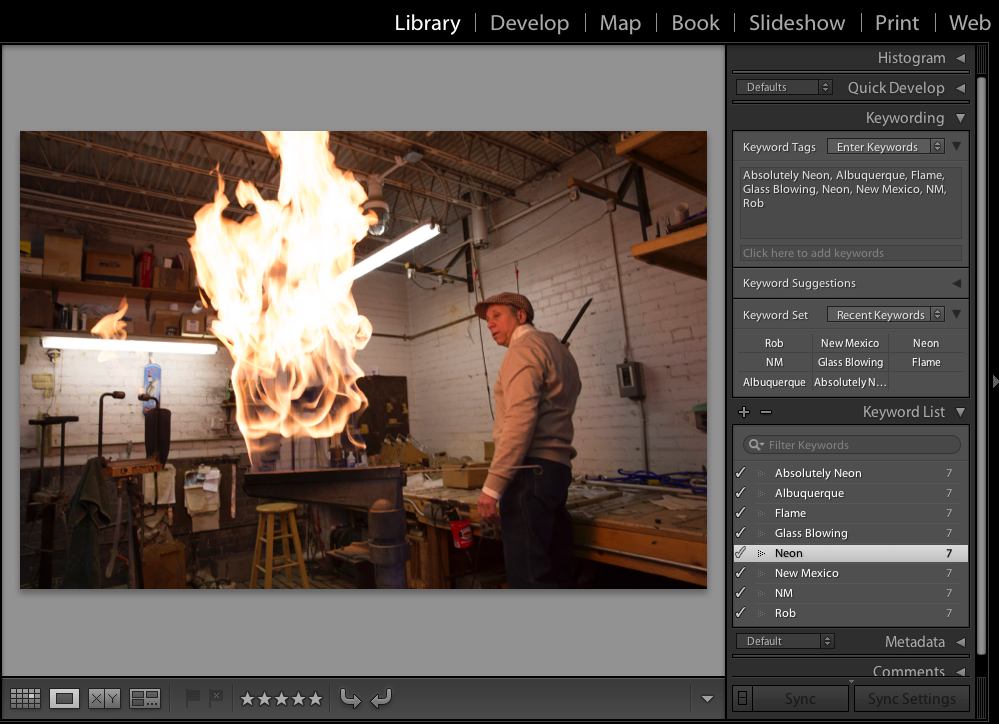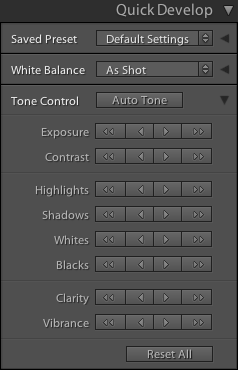The Library module is where you view, sort, manage, organize, compare, and rate the photos in your catalog. It’s your home base for working with photos after importing them into Lightroom Classic.

A. Module Picker B. Image display area C. Library Filter bar D. Identity plate E. Panels for working with source photos F. Filmstrip G. Toolbar H. Panels for working with metadata, keywords, and adjusting images I. Sync

Starting from the February 2022 release (version 11.2), experience improved responsiveness in the Library module, especially during multitasking. Apply a preset to a set of images (batch edit) and simultaneously navigate through or search folders or collections, and also apply metadata filters.
You can now:
- Apply a preset to a set of images and at the same time navigate to a different folder and change image attributes like ratings for another set of images.
- Apply a preset to a set of images and simultaneously initiate the folder/collection search and use metadata filters.
Watch the video to learn more:
View photos
The Library module offers several view modes that let you see your photos in different sizes and easily compare them. Switch between views using the keyboard shortcuts indicated, and see Switching between Grid, Loupe, Compare, and Survey views for more detail.
Grid view (G)
Grid view displays photos as thumbnails in cells, which can be viewed in compact and expanded sizes. The Grid view gives you an overview of your entire catalog or specific groups of photos for rotating, sorting, organizing, and managing.
Loupe view (E)
Displays a single photo. Controls let you view the entire photo or zoom in to see part of it. Zoom levels up to 11:1 are available. When you’re in the Grid or Survey view, double-clicking a photo displays the image in Loupe view.
Zoom in to photos by clicking in the Navigator panel or by selecting a magnification level at the top of the Navigator panel.
Compare view (C)
Displays photos side by side so that you can evaluate them.
Survey view (N)
Displays the active photo with selected photos so that you can evaluate them. The active photo has the lightest colored cell. Change the active photo by clicking a different thumbnail, and deselect a photo in Survey view by clicking the X in the lower-right corner of the thumbnail. (See step 2 for more about active and selected photos.)


If you're looking for the Reference view and Before/After view available in the Develop module, see Views in the Develop module.
You can also display any of these views of the Library module in a second window, which you can view on a second monitor, if you have one. See Displaying the Library on a second monitor.
Select photos
The Folders and Collections panels on the left side of the Library module let you select specific folders or collections to display. Use them to navigate and manage the folders that contain your photos and to view collections of photos.
Click any photo in the Filmstrip or in the preview area to select it. You can select one or more photos using common selection commands: Shift-click to select photos in a sequence in Grid view, for example, and Ctrl-click (Windows) or Command-click (Mac OS) to select nonsequential images.
When you select a photo, it becomes the active photo. You can select multiple photos, but only one photo at a time is the active photo. Selected photos are indicated in the grid and the Filmstrip by a thin border around the thumbnail and a lighter-gray cell than deselected photos. The lightest colored cell indicates the active photo. See Select photos in the Grid view and the Filmstrip.


Open and close panels on the left and right sides of Lightroom Classic modules by clicking the disclosure triangle next to the panel name.
Find and filter photos
When you have hundreds or thousands of photos, locating a specific image might not be as easy as simply selecting a folder or a collection. Luckily, the Library Filter bar at the top of the Grid view can help. The Library Filter bar lets you find photos by various types of metadata: keyword, rating, color label, and more.
- Select one or more folders or collections to search. Or, select All Photographs in the Catalog panel.
- Press \ to display the Library Filter bar if it's not visible.
- In the Library Filter bar, select a criteria by which to filter. If you want to find all photos with a certain keyword, for example, click Text.
- Specify filter criteria. For example, choose Text > Keywords > Contains All and type rodeo in the search box. For a text filter, press Enter (Windows) or (Return).


Photos that meet your criteria appear in the Grid view.
You can also filter photos by using the Filter menu in the upper-right corner of the Filmstrip. See Find photos using the Library Filter bar and Filter photos in the Filmstrip and the Grid view.
Organize your photos
Collections are one of the basic ways to organize photos in Lightroom Classic. Collections group photos in one place for easy viewing or for performing different tasks. For example, photos in a collection can be assembled into a slideshow or used to create a photo book. Collections are listed in the Collections panel of every module, so they can be selected anytime you need them. See Work with photo collections.
Another organizational tool in Lightroom Classic is stacking. Stacking is a way to group a set of visually similar photos together, making them easy to manage. Stacks are useful for keeping multiple photos of the same subject or a photo and its virtual copies in one place. Stacks also reduce clutter in the Grid view and the Filmstrip. See Group photos into stacks.
Finally, you can apply ratings, flags, and color labels to photos. Star ratings are a universal way to rank the quality of a photo — a 5-star photo is great, a 2-star photo is so-so. Flags are an extension of this idea: flag a photo as a Pick or a Reject, indicating it's a keeper or that you're not going to process it. Color labels are more individual, and you can use them in any way that's meaningful. Perhaps photos with a yellow label need a white-balance adjustment, or photos with a red label need to be cropped. See Flag, label, and rate photos.
Add metadata and keywords to photos
Applying keywords and metadata are additional tools for organizing and finding photos.
Keywords are text metadata that describe the important contents of a photo. You tag photos with keywords using the Rewording and Keyword Lists panels. For example, select a photo in the Grid view, and in the text entry box in the Keywording panel, enter words separated by commas. You can also apply keyword sets or apply keywords using the Painter tool. See Use keywords.
Metadata is a set of standardized information about a photo, such as the photographer’s name; the image resolution and color space; and copyright information. Most digital cameras attach some basic metadata — such as height, width, file format, and the time the image was taken — to a photo, but you can edit that information and add more in the Library module. See Metadata basics and actions.


Make quick adjustments to photos
The Quick Develop panel lets you quickly apply tone adjustments to photos. The tone adjustments in the Quick Develop panel in the Library module are the same as their counterparts in the Develop module. However, the Develop module has more precise controls for editing images. See Use the Quick Develop panel.

